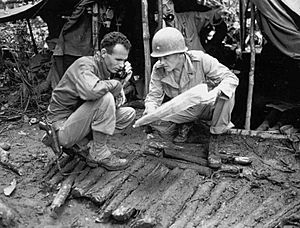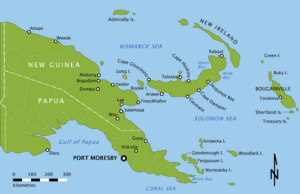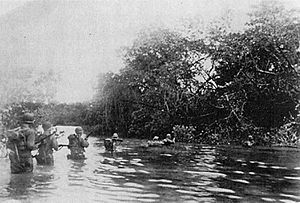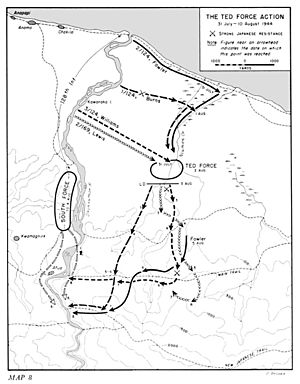Battle of Driniumor River facts for kids
Quick facts for kids Battle of Driniumor River |
|||||||
|---|---|---|---|---|---|---|---|
| Part of the New Guinea Campaign | |||||||
 Brig. Gen. Julian Cunningham (right), the CO of the 112th Cavalry Regiment, reviews a map at a command post near Driniumor River on 9 August 1944. |
|||||||
|
|||||||
| Belligerents | |||||||
| Commanders and leaders | |||||||
| Units involved | |||||||
|
XI Corps
|
18th Army
|
||||||
| Strength | |||||||
| ~ 20,000 | |||||||
| Casualties and losses | |||||||
| 440 killed 2,550 wounded 10 missing |
8,000–10,000 | ||||||
The Battle of Driniumor River was a major fight during World War II in New Guinea. It happened between 10 July and 25 August 1944. Japanese forces attacked American troops near the Driniumor River, close to a town called Aitape. The Japanese wanted to take Aitape back, but the American forces stopped their attack. This battle was part of the larger New Guinea Campaign.
Why the Battle Happened
The Driniumor River is about 20 kilometers (12 miles) east of Aitape. In 1942, Japan had taken control of much of New Guinea. But by 1943, the Allies (like the United States and Australia) were pushing back.
Allied Advance in New Guinea
In early 1944, the Allies started landing troops along the coast of New Guinea. Their goal was to move towards the Philippines. On April 22, 1944, Allied forces landed at Hollandia and Aitape. This move cut off the Japanese 18th Army, which was trying to retreat.
After taking Aitape, U.S. troops set up defenses. They created a perimeter (a protected area) around the airfields. This area stretched about 30 miles (48 km) east of Aitape. American soldiers also sent out patrols to find Japanese troops. The main Japanese forces were near Wewak, about 90 miles (145 km) away.
Japanese Preparations
The Japanese 18th Army, led by Lieutenant-General Hatazō Adachi, was in the area. This army had already suffered heavy losses in earlier battles. They had about 20,000 soldiers, but they were not well-supplied. They had only half the ammunition they needed for a big battle. Their soldiers also received only half of their usual food rations.
Japanese intelligence showed that the 18th Army was planning to attack the Driniumor River. They wanted to break through the Allied lines and take Aitape back. They built a 60-kilometer (37-mile) road to bring supplies forward. But most supplies still had to be carried by hand.
Allied Intelligence and Reinforcements
Even though the Allies knew the Japanese were planning something, their information was confusing. American commanders thought the Japanese might not be able to attack because of their supply problems.
However, General Walter Krueger ordered more troops to the area. The 43rd Infantry Division and parts of the 31st Infantry Division arrived. By late June, the Allied forces were strong. Major General Charles P. Hall set up his headquarters at Aitape. A special force, led by Brigadier General Julian W. Cunningham, was sent to guard the Driniumor River.
Despite these preparations, the Japanese attack on July 10 caught the Americans by surprise.
The Battle Begins
On the night of July 10, around 10,000 Japanese soldiers attacked across the Driniumor River. They brought artillery guns through the jungle to support their attack.
Initial Japanese Attack
The Japanese plan was for three regiments to attack at the same time. But the jungle terrain made it hard to coordinate. The attack started at 10:55 PM on July 10. Some units attacked earlier than planned, and others were delayed.
The U.S. 128th Infantry Regiment faced the main Japanese assault. They used machine guns and mortars to fight back. American artillery also fired on the attacking Japanese. This caused heavy losses for the Japanese.
One American company, Company E, was hit very hard. Many of its soldiers were killed or wounded. Some survivors had to retreat, while others were stuck behind Japanese lines for days. Despite heavy losses, the Japanese managed to break through the American line.
American Withdrawal and Counterattack
Because of the Japanese breakthrough, U.S. forces started to pull back on July 11 and 12. They moved about 3 miles (4.8 km) west. The Japanese, however, had trouble taking full advantage of their success due to their own supply and communication problems.
U.S. commanders ordered a counterattack. On July 13 and 14, American forces worked to close the gap in their lines. They used several artillery battalions to support their attack. Two battalions of the U.S. 124th Infantry Regiment joined the fight. They disrupted the Japanese forces and caused more clashes.
Fighting for Afua
The Japanese launched another attack around July 15 and 16. This led to heavy fighting with U.S. cavalry and infantry units. The village of Afua was captured by the Japanese at least twice, but they were forced to withdraw each time.
Throughout late July, the fighting continued in the jungle. It often turned into hand-to-hand combat. Japanese troops tried to encircle American positions. By July 22, the Japanese had captured Afua. But the next day, American reinforcements arrived.
The Japanese commander, Adachi, decided to commit more of his forces to take Afua. He sent his reserve regiment and most of the 41st Division to attack alongside the 20th Division. This attack started on July 29 and lasted several days. It gained some ground but resulted in very heavy Japanese casualties.
U.S. Counteroffensive and Japanese Retreat
Meanwhile, U.S. forces prepared their own counteroffensive from July 29 to 31. They planned to go around the Japanese forces attacking Afua. American troops pushed east of the Driniumor River, then turned south and west to surround the Japanese.
By early August, the Japanese attack on Afua had stopped. They were pushed back east across the Driniumor River. The Japanese forces near the coast then went on defense. On August 4, Adachi ordered a full retreat towards Wewak.
Fighting continued until around August 10 as U.S. troops chased the Japanese rearguard. American units, including the 43rd Division, took over the pursuit. They patrolled towards other villages but couldn't find the main Japanese forces until they reached strong positions on the Dandriwad River. At this point, the U.S. commander, Krueger, stopped the advance. The battle officially ended on August 25.
Support During the Battle
Air support was provided by Australian and U.S. aircraft. They flew from nearby airfields. Navy ships, including Australian and U.S. cruisers and destroyers, also helped. They fired their guns to support the ground troops. Allied PT boats and destroyers also stopped Japanese supply convoys along the coast. Because of the thick jungle, most supplies for U.S. troops were dropped from planes.
Aftermath of the Battle
Four U.S. soldiers received the Medal of Honor for their bravery in this battle. They were Private Donald R. Lobaugh, Staff Sergeant Gerald L. Endl, Second Lieutenant George W. G. Boyce, Jr., and Second Lieutenant Dale Eldon Christensen. All four were honored after they had died.
The Americans suffered about 3,000 casualties. This included 440 killed, 2,550 wounded, and 10 missing. The Japanese lost between 8,000 and 10,000 men. Many of these Japanese losses were not from fighting, but from starvation and disease.
The Battle of Driniumor River lasted four weeks. It was one of the most costly battles in the New Guinea campaigns. Only the earlier battles at Gona, Buna, and Sanananda had more casualties.
After the battle, U.S. forces focused on defending their base at Aitape. Adachi reorganized his Japanese forces near Wewak. Because of their heavy losses and lack of supplies, the Japanese had to find food for themselves. Later in 1944, Australian forces arrived to relieve the U.S. troops. The Japanese then fought against the Australians in the Aitape–Wewak campaign.




